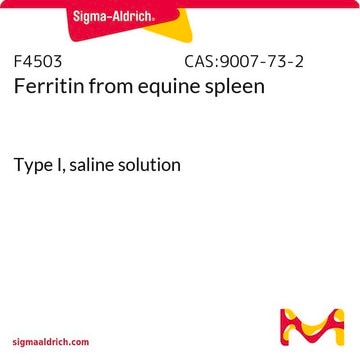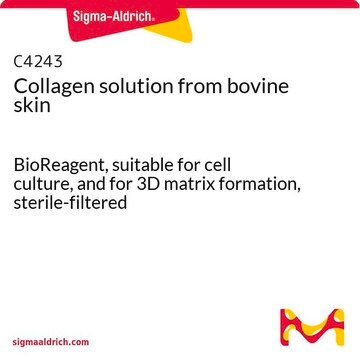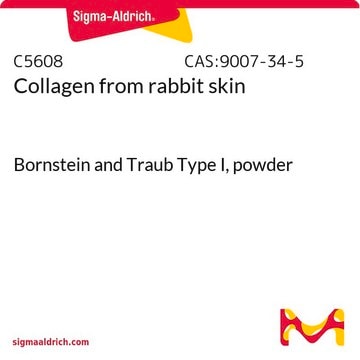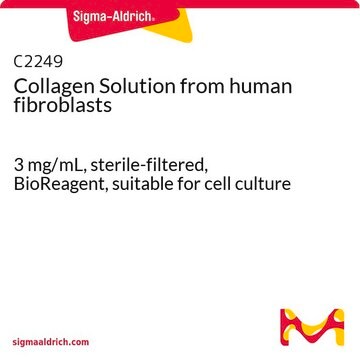C8897
Collagen from rat tail
Bornstein and Traub Type I (Sigma Type VII), powder
Sign Into View Organizational & Contract Pricing
All Photos(1)
About This Item
Recommended Products
biological source
rat tail
form
powder
technique(s)
cell culture | mammalian: suitable
solubility
aqueous acid: soluble
UniProt accession no.
storage temp.
2-8°C
Gene Information
rat ... Col1a1(29393)
Looking for similar products? Visit Product Comparison Guide
Application
This product is intended to produce thin layer coatings on tissue culture plates to facilitate attachment of anchorage-dependent cells, recommended for use at 6-10 μg/cm2. It is NOT intended for production of 3-D gels. Type I collagen is often used in cell culture as an attachment substratum with myoblasts, spinal ganglia, hepatocytes, embryonic lung, heart explants, fibroblasts, endothelial cells, and islet cells have all been cultured successfully on films or gels of type I collagen. Collagen type I may also be used in research of Idiopathic pulmonary fibrosis (IPF), studies on the effect of ER stress IPF on lung fibroblasts. Collagen in acidic solution can produce three dimensional scaffolding with use in bioengineering and cell culture applications.
Biochem/physiol Actions
Type I collagen is a component of skin, bone, tendon, and other fibrous connective tissues.
Components
All collagen molecules are composed of three polypeptide chains arranged in a triple helical conformation, with a primary structure that is mostly a repeating motif with glycine in every third position and proline or 4-hydroxyproline frequently preceding the glycine residue. Type I collagen differs from other collagens by its low lysine hydroxylation and low carbohydrate composition.
Preparation Note
This product was prepared by a modification of the extraction method of Bornstein, M.B., Lab. Invest., 7, 134 (1958). It is an acid soluble collagen. It dissolves in water with acetic acid added to pH 3.0 at 5 mg/mL, yielding an opalescent, colorless solution.
Other Notes
Collagen is classified into a number of structurally and genetically distinct types. We use the nomenclature proposed by Bornstein and Traub. Do not confuse Sigma type designations with recognized collagen classification types.
Storage Class
11 - Combustible Solids
wgk_germany
WGK 1
flash_point_f
Not applicable
flash_point_c
Not applicable
ppe
Eyeshields, Gloves, type N95 (US)
Certificates of Analysis (COA)
Search for Certificates of Analysis (COA) by entering the products Lot/Batch Number. Lot and Batch Numbers can be found on a product’s label following the words ‘Lot’ or ‘Batch’.
Already Own This Product?
Find documentation for the products that you have recently purchased in the Document Library.
Customers Also Viewed
Satu O A Koskinen et al.
Pflugers Archiv : European journal of physiology, 444(1-2), 59-72 (2002-04-27)
Acute downhill running has been shown to activate matrix metalloproteinase- (MMP-) 2 and to change type IV collagen concentration in some muscle types. In order to study the influence of more intense exercise on total collagen and type IV collagen
J J Herbst et al.
The Journal of biological chemistry, 270(43), 26000-26005 (1995-10-27)
Insulin causes the activation of phosphatidylinositol 3-kinase (PI 3-kinase) through complexation of tyrosine-phosphorylated YMXM motifs on insulin receptor substrate 1 with the Src homology 2 domains of PI 3-kinase. Previous studies with inhibitors have indicated that activation of PI 3-kinase
M Berry et al.
Methods in molecular medicine, 2, 503-516 (1996-01-01)
The conjunctiva is the mucous membrane of the eye. It is a delicate transparent epithelium with its own stroma overlying the tough white sclera, which forms the ball of the eye. Only at the circular limbus, where the sclera meets
Hao Liu et al.
Nature communications, 12(1), 5796-5796 (2021-10-06)
The axonemal central pair (CP) are non-centrosomal microtubules critical for planar ciliary beat. How they form, however, is poorly understood. Here, we show that mammalian CP formation requires Wdr47, Camsaps, and microtubule-severing activity of Katanin. Katanin severs peripheral microtubules to
Katarina Wolf et al.
The Journal of cell biology, 201(7), 1069-1084 (2013-06-27)
Cell migration through 3D tissue depends on a physicochemical balance between cell deformability and physical tissue constraints. Migration rates are further governed by the capacity to degrade ECM by proteolytic enzymes, particularly matrix metalloproteinases (MMPs), and integrin- and actomyosin-mediated mechanocoupling.
Our team of scientists has experience in all areas of research including Life Science, Material Science, Chemical Synthesis, Chromatography, Analytical and many others.
Contact Technical Service








